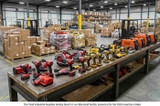Emerging Trends in Pneumatic Air Tools for 2024: Innovations and Market Predictions
Emerging Trends in Pneumatic Air Tools for 2024
In the intricate tapestry of modern machinery and technological marvels, pneumatic air tools have carved a niche. These powerhouses, driven by compressed air, have seamlessly integrated into various industries, from the meticulous craftsmanship in automotive factories to the rigorous demands of construction sites. As we move into 2024, we must gaze into the future of pneumatic air tools, deciphering the upcoming innovations and trends.
Key Takeaway
The future of pneumatic air tools is bright, driven by technological advancements, industry-specific applications, and a focus on sustainability. As we move into 2024, these tools are set to become even more efficient, versatile, and environmentally friendly. By investing in high-quality pneumatic air tools and staying informed about emerging trends, businesses can significantly enhance productivity, reduce environmental impact, and stay ahead in a competitive market. For those looking to optimize their operations with cutting-edge pneumatic technology, Tend Industrial Supplies offers a comprehensive range of tools and expert guidance. Explore our offerings at Tend Industrial Supplies or contact us at sales@tendsupplies.com for personalized support.
Technological Advancements
The world of pneumatic air tools is amid a technological metamorphosis. Gone are the days when these tools were mere instruments of brute force. Today, they epitomize innovative power. The focus on energy efficiency has led to tools that deliver unparalleled performance while consuming minimal air. Ergonomics, once an afterthought, is now at the forefront of design philosophies, ensuring that tools are powerful and comfortable. The dawn of the IoT era has seen these tools evolve into smart devices capable of communicating with other gadgets, providing invaluable data, and ensuring they operate efficiently.
Industry-Specific Applications
The versatility of pneumatic air tools is genuinely astounding. In the automotive realm, they've become the backbone of assembly lines, aiding in everything from intricate engine repairs to routine tire replacements. With its diverse demands, the construction sector leans heavily on these tools for drilling, chiseling, and painting. Manufacturing units, where precision is paramount, employ these tools to ensure that every product that rolls off the line is of the highest caliber. This adaptability and constant innovations ensure that pneumatic air tools remain indispensable across many industries.
Environmental Impact
The clarion call for sustainability has resonated across industries, and the realm of pneumatic air tools is no exception. Inherently more energy-efficient than many alternatives, these tools are transforming to minimize their environmental impact further. The use of recycled materials, reduction in wastage during production, and the development of tools that consume even less air are just a few of the steps being taken. As the world grapples with environmental challenges, the pneumatic air tool industry is poised to lead toward a greener future.
Global Market Analysis
The global landscape of pneumatic air tools is as dynamic as it is diverse. With its burgeoning industries and rapid urbanization, the Asia-Pacific region is a hotbed for these tools. North America and Europe, with their mature markets, continue to innovate and evolve. Emerging markets in Africa and South America present many opportunities driven by industrial growth and infrastructural development. As 2024 looms, market analysts predict a surge in demand, innovations tailored for specific regions, and a potential shift in market leaders.
The global pneumatic tools market is expected to grow significantly in the coming years. The market was valued at nearly US$ 69.73 Bn in 2020 and is estimated to grow at a CAGR of 7.13% to reach US$ 112.92 Bn by 2029. Pneumatic tools are powered by compressed air provided by an air compressor. The market report comprehensively analyzes critical segments, trends, and forecasts for the global pneumatic tools market. The market outlook for 2031 shows that the global pneumatic tools market size was valued at US$ 89.6 Bn in 2022. The market is projected to reach US$ 118.5 billion by 2024, with a compound annual growth rate of 5.2%. The increasing demand for pneumatic tools in various industries, including automotive, construction, and manufacturing, is driving the market growth.
User Safety and Training
The power of pneumatic air tools is awe-inspiring. However, with great power comes great responsibility. Recognizing the potential hazards, manufacturers have redoubled their efforts to enhance safety features. Anti-vibration handles, noise reduction mechanisms, and fail-safe switches are standard across premium tools. But hardware is just one piece of the puzzle. Comprehensive training programs, both online and offline, are being rolled out, ensuring that users are well-equipped to handle these tools safely and efficiently.
Productivity Gains of Pneumatic Air Tools
Pneumatic air tools have been shown to increase productivity in various industries. Here are some examples:
- Increased Production Rate: Pneumatic tools are not sensitive to overloads and can maintain stated power, increasing production rate.
- Fewer Interruptions: Pneumatic tools are less likely to malfunction or require repairs, which means fewer interruptions and increased productivity.
- Significant Gains in Productivity: Air tools offer many advantages that may result in significant gains in productivity and overall savings for businesses.
- Energy Savings: Switching from pneumatic to electric tools can save energy. However, the total cost of operation may present a different story if the electric tools have a different lifespan and cost than the pneumatic tools.
- Power and Precision: Pneumatic tools are known for their power and precision, which can help to increase productivity in modern industries.
- Productivity Gains: Running abrasives at the proper speed with governed air grinders results in a more significant percentage of material removal in a given time, resulting in productivity gains.
By utilizing pneumatic air tools, businesses can increase their productivity and achieve their goals more efficiently.
Case Studies of Productivity Increase Due to the Use of Pneumatic Air Tools
Real-world applications often speak louder than theoretical postulations. In Germany, a renowned car manufacturer's transition to state-of-the-art pneumatic tools led to a staggering 30% increase in production efficiency. Meanwhile, in Dubai, the construction of a skyscraper, touted to be among the world's tallest, saw its timeline reduced by two months, all thanks to the strategic deployment of advanced pneumatic tools. These success stories underscore the transformative potential of these tools.
Productivity Increase Achieved by Vortec
One case study that demonstrates the use of air tools to increase productivity in a manufacturing setting is a paper company that increased its production rates while improving the quality of its products. The company achieved this by implementing air solutions that improved its compressed air system.
Here are some of the ways that the paper company was able to improve its productivity with air solutions:
- Upgraded Their Compressed Air System: The paper company upgraded its compressed air system to improve the efficiency of its air tools. This helped reduce the time it took to complete tasks and increased its production rates.
- Improved the Quality of Their Products: By upgrading their compressed air system, the paper company improved the quality of their products. This helped reduce the amount of waste and rework, which increased their productivity.
- Reduced Maintenance Costs: The paper company upgraded its compressed air system to reduce maintenance costs. This reduced downtime and increased productivity.
The case study on the paper company demonstrates how air tools can be used to increase productivity in a manufacturing setting. By upgrading its compressed air system, the company could improve the efficiency of its air tools, improve the quality of its products, and reduce its maintenance costs. This resulted in increased production rates and improved productivity.
Emerging Trends in Pneumatic Air Tools
The global pneumatic market is experiencing rapid growth, driven by the increasing adoption of automation in various industries. Pneumatic tools are not sensitive to overloads and can maintain stated power, giving a higher production rate and increasing productivity. Additionally, pneumatic tools are less likely to malfunction or require repairs, which means fewer interruptions and increased productivity. Wireless technology is being used to enhance pneumatics for automation, resulting in more complex automation systems. These emerging trends in pneumatic air tools drive the growth of the market and are expected to continue to do so in the coming years.
Buyer's Guide
Making an informed choice can be daunting in the vast sea of pneumatic air tools. Prospective buyers should prioritize their specific needs, power, precision, or portability. Brand reputation, warranty, and after-sales service are crucial factors. Lastly, always keep an eye out for user reviews and expert recommendations.
The horizon of 2024-2030 promises a confluence of innovation, efficiency, and sustainability in the world of pneumatic air tools. As industries evolve and demands shift, these tools stand ready to meet the challenges head-on. For professionals, enthusiasts, and casual users alike, the future holds immense potential, teeming with possibilities.
For more information and to explore our range of pneumatic tools, visitTend Industrial Supplies or contact us at sales@tendsupplies.com.
FAQs
Q: How have technological advancements impacted pneumatic air tools? A: Technological advancements have made pneumatic air tools more energy-efficient, ergonomic, and smart, with features like IoT integration for better performance and data communication.
Q: What industries benefit the most from pneumatic air tools? A: Industries such as automotive, construction, manufacturing, and woodworking benefit significantly from pneumatic air tools due to their power, precision, and versatility.
Q: How do pneumatic air tools contribute to environmental sustainability? A: Pneumatic air tools are inherently more energy-efficient and are being developed using recycled materials and processes that reduce environmental impact, contributing to sustainability efforts.
Q: What is the expected growth of the global pneumatic tools market? A: The global pneumatic tools market is expected to grow significantly, with projections reaching up to US$ 118.5 billion by 2024, driven by increasing demand in various industries.
Q: How can businesses improve productivity using pneumatic air tools? A: Businesses can improve productivity by using pneumatic air tools with high power and precision, fewer interruptions, and efficient performance, resulting in increased production rates and reduced maintenance costs.
For further inquiries or assistance with selecting the best pneumatic air tools for your needs, visitTend Industrial Supplies or contact us at sales@tendsupplies.com.









